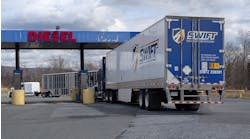The California Air Resources Board (CARB) has put together several “phase-in” plans to help fleets comply with its heavy-duty tractor-trailer greenhouse gas (GHG) regulation mandate that went into effect Jan. 1 this year – giving small fleets, in particular, a nearly seven-year window to meet the new rules if they participate in the state agency’s program. (Read more CARB news)
During a conference call with reporters reviewing the GHG compliance efforts undertaken by Tacoma, WA-based carrier Interstate Distributor Co., Yvonne Sanchez, an air resources engineer with CARB, explained that small fleets – those with 21 vehicles or less – operating equipment governed by these new regulations have until July 1, 2012, to submit a compliance plan to CARB to gain the phase-in designation.
“If smaller fleets submit a phase-in plan for their equipment to us by July 1, 2012, they can have until July 1, 2017 to achieve full compliance with the [GHG] rule,” she said. The phase-in option for larger fleets, however, has already passed as the deadline for participating in that program was July 1 this year.
Sanchez added that some grant funding is being made available to smaller fleet operators to help them comply with the new rule, similar to the $28 million Voucher Incentive Program (VIP) modified by CARB earlier this year to help more independent truckers qualify for the purchase of a cleaner-running vehicle.
Modifications to the VIP program, made in March, allowed for the inclusion of trucks with 2002 and older engines, whereas previously only trucks with 1993 and older engines were eligible. Also tucks with mileage as low as 15,000 miles per year are now eligible, whereas before a truck had to operate a minimum of 30,000 miles per year or consume 4,700 gallons of diesel fuel per year during the previous two years to qualify.
Sanchez stressed that the purpose of these rules is to not only reduce air pollution, but save truckers money as well over the long term.
“Between 2010 and 2020, we estimate that this {GHG] regulation alone will save about $8.6 billion, as well as 750 million gallons of diesel fuel in California and five billion gallons of diesel fuel across the nation,” she said. “It will also reduce greenhouse gas emissions by approximately one million metric tons of carbon dioxide-equivalents by 2020, statewide.”



